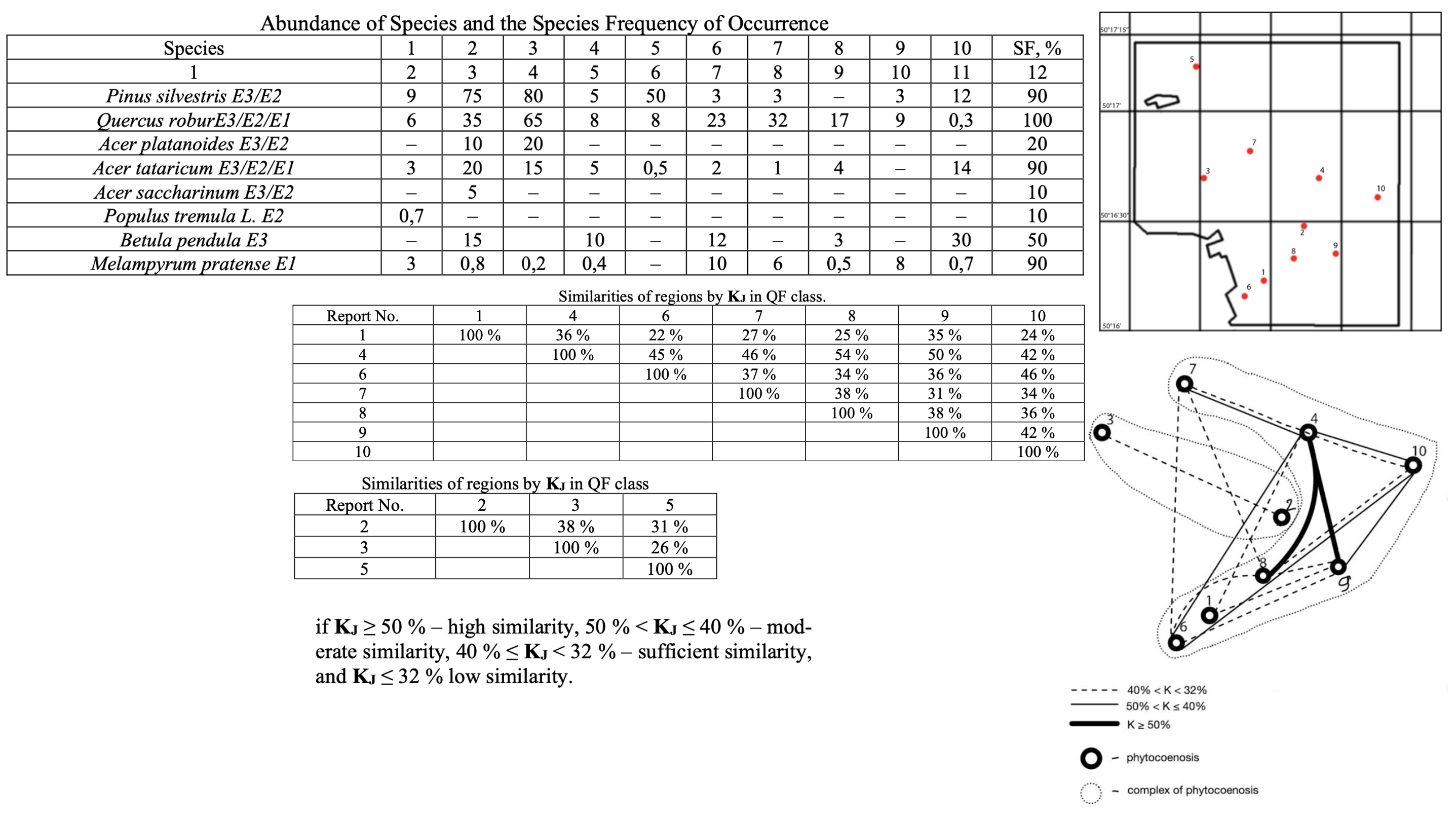Analysis of the modern forest fund
DOI:
https://doi.org/10.15587/2519-8025.2024.312550Keywords:
geobotany, phytocoenosis, projective cover, graph of similarity, vitality, geobotanical description, Jaccard coefficientAbstract
The article is dedicated to the study of the forests in the southern part of Kyiv. The article presents data on the projective cover, distribution, vitality, frequency of occurrence, and other data, obtained from 10 geobotanical descriptions in the Holosiivskyi district of Kyiv. The further actions were made with the data observed, and as a result, the graph of similarity was created. Nowadays the territories of cities expand, causing the enhanced tempo of urbanization and this study checks whether the forest is hugely affected or not. Some evaluations could set the pattern and help to estimate the influence on forestry in the very near future.
The aim of the study is to inventory the modern forest fund in Kyiv and observe data to determine the influence of the urbanization on forest in the future.
Materials and methods. Among of the methods for the observation were used geobotanical descriptions, monitoring and various computing methods, including the sorting, creating plots to make evaluations, GPS fixation, and the programme to create a map for the more thorough description of quadrants.
Results. The vegetation in the analyzed areas is very diverse, with 68 species identified. Among the dominant species, Quercus robur was found in the tree layer, and Molinia caerulea along with Convallaria majalis in the herbaceous layer. The Betula pendula and Quercus robur formations have the highest species diversity, with 24 species each. The vegetation classes Querco-Fagetea and Vacinio-Piceateae were analyzed.
Conclusions. The forest, in which the research was conducted, is mildly affected by urbanization. This inference may be made by the common species on this latitude, based on the previous researches
References
- Dada, S. A. O. (2014). Towards sustainable quality forage production: an evaluation of the effect of soil PH on grass forage mixture nutritive quality in Macon county, Alabama. 2014 Annual Professional Agricultural Conference. http://dx.doi.org/10.13140/RG.2.1.4664.0728
- Temperate Plants Database (2024). Ken Fern. Temperate.theferns.info. Available at: https://temperate.theferns.info/plant/Acer+tataricum
- Onyshchenko, V. A. (2013). Lisova roslynnist ur. Holosiivskyy lis (m. Kyiv). Biolohichni systemy. Naukovyi visnyk Chernivetskoho universytetu, 5 (1), 113.
- Onyshchenko, V. A. (2011). Vegetation of Teremky Area (Holosiyivsky National Nature Park, Kyiv. Biolohichni systemy, 3 (1), 56–74.
- Podani, J. (2021). The wonder of the Jaccard coefficient: from alpine floras to bipartite networks. Flora Mediterranea, 31. https://doi.org/10.7320/flmedit31si.105
- Rozpodil nasinnievykh nasadzhen za klasamy bonitetu na pidstavi viku i vysoty (za Orlovym M. M.) (Vytiah) (2020). Natsionalnyi universytet “Chernihivska politekhnika”.
- Touarfia, M., Bouali, N., Djouamaa, A., Maazi, M. C., Houhamdi, M. (2021). Influence of edaphic factors on the structure and distribution of plant species in and around Mekeiman Marsh Wetland, Northeast of Algeria. Biodiversitas Journal of Biological Diversity, 22 (6). https://doi.org/10.13057/biodiv/d220625
- Schaefer, M. (1992). Wörterbuch of the Ökologie. Spektrum, Jena.
- Felbaba-Klushyna, L. M., Komendar, V. I. (2001). Fitotsenolohiia z osnovamy synfitosozolohii. Uzhhorod: Uzhhorodskyi natsionalnyi universytet, 186.
- Vandepitte, K., Roldán-Ruiz, I., Jacquemyn, H., Honnay, O. (2010). Extremely low genotypic diversity and sexual reproduction in isolated populations of the self-incompatible lily-of-the-valley (Convallaria majalis) and the role of the local forest environment. Annals of Botany, 105 (5), 769–776. https://doi.org/10.1093/aob/mcq042
- Abduloieva, O. S., Solomakha, V. A. (2011). Fitotsenolohiia. Kyiv: Fitosotsiotsentr, 239.
- Dydukh, Ya. P. (1992). Rastytelnіi pokrov hornoho Krima (struktura, dynamyka, evoliutsyia y okhrana): Ynstytut botanyky ym. N. H. Kholodnoho. Kyiv: Naukova Dumka, 256.

Downloads
Published
How to Cite
Issue
Section
License
Copyright (c) 2024 Myron Lutskiv

This work is licensed under a Creative Commons Attribution 4.0 International License.
Our journal abides by the Creative Commons CC BY copyright rights and permissions for open access journals.
Authors, who are published in this journal, agree to the following conditions:
1. The authors reserve the right to authorship of the work and pass the first publication right of this work to the journal under the terms of a Creative Commons CC BY, which allows others to freely distribute the published research with the obligatory reference to the authors of the original work and the first publication of the work in this journal.
2. The authors have the right to conclude separate supplement agreements that relate to non-exclusive work distribution in the form in which it has been published by the journal (for example, to upload the work to the online storage of the journal or publish it as part of a monograph), provided that the reference to the first publication of the work in this journal is included.








